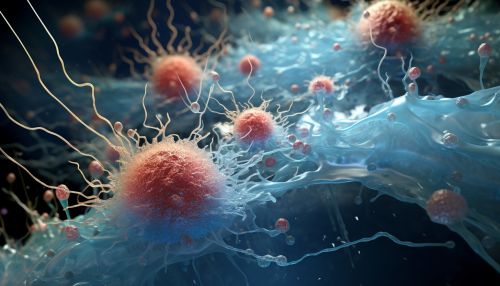Cancer Metastasis
Introduction
Cancer metastasis is the spread of cancer cells from the place where they first formed to another part of the body. In metastasis, cancer cells break away from the original (primary) tumor, travel through the blood or lymph system, and form a new tumor in other organs or tissues of the body. The new, metastatic (secondary) tumors are the same type of cancer as the primary tumor. For example, if breast cancer metastasizes to the lung, the secondary tumor is made up of abnormal breast cells, not abnormal lung cells. The disease in the lung is metastatic breast cancer, not lung cancer.


Mechanism of Metastasis
Cancer metastasis involves a complex series of steps in which cancer cells leave the original tumor site and migrate to other parts of the body via the bloodstream, the lymphatic system, or by direct extension. To do so, malignant cells break away from the primary tumor and attach to and degrade proteins that make up the surrounding extracellular matrix (ECM), which separates the tumor from adjoining tissues. By degrading these proteins, cancer cells are able to breach the ECM and escape.
Metastatic Cascade
The metastatic cascade is the series of steps that a cancer cell follows to form a metastasis. The steps are as follows:
- Detachment and Invasion: Cancer cells detach from the primary tumor and invade surrounding normal tissue.
- Intravasation: Cancer cells invade and move through the walls of nearby blood vessels or lymph vessels.
- Circulation: Cancer cells are transported through the bloodstream or lymphatic system.
- Arrest and Extravasation: Cancer cells stop moving as they are lodged in capillaries at a distant location and invade the walls of the capillaries and enter the surrounding tissue.
- Proliferation: Cancer cells multiply at the distant location to form tiny tumors known as micrometastases.
- Angiogenesis: New blood vessels form at the site of the micrometastases, providing the nutrients and oxygen needed for the micrometastases to grow into macroscopic secondary tumors.
Factors Influencing Metastasis
Several factors influence the likelihood and location of metastasis in a patient with cancer. These include the type of cancer, the stage of the cancer, the patient's age and general health, and the molecular characteristics of the cancer cells. Some cancers are more likely to metastasize to certain organs or tissues. For example, prostate cancer cells are more likely to spread to bones, while lung cancer cells are more likely to spread to the brain.
Diagnosis and Staging
Metastasis is usually diagnosed through a combination of imaging tests, such as CT scans or MRI scans, and biopsies. A biopsy involves taking a small sample of tissue from the suspected metastatic site for examination under a microscope. The presence of cancer cells in this sample confirms the diagnosis of metastasis.


Treatment
Treatment for metastatic cancer aims to slow the growth or spread of cancer cells. It depends on many factors, including the type of primary cancer, the size and location of the metastasis, the patient's age and general health, and the types of treatments the patient has had in the past. In general, metastatic cancer is very difficult to cure. However, treatment can help control the cancer, relieve symptoms, and extend and improve the patient's quality of life.
Prognosis
The prognosis for metastatic cancer depends on many factors, including the type and stage of the primary cancer, the number and location of metastases, the patient's age and general health, and how well the cancer responds to treatment. In general, the prognosis for metastatic cancer is not as good as for localized (non-metastatic) cancer. However, with advances in cancer treatment, many people with metastatic cancer are living longer and enjoying a good quality of life.
